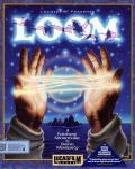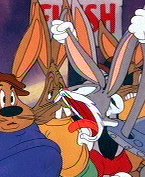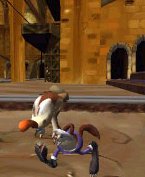 5:56
a.m.: I'm exhausted. In approximately twenty-four hours, I will be hitting
the snooze button on my alarm clock, for the first of what I imagine will be at
least four times. Then, I will get up and go to work.
5:56
a.m.: I'm exhausted. In approximately twenty-four hours, I will be hitting
the snooze button on my alarm clock, for the first of what I imagine will be at
least four times. Then, I will get up and go to work.
In approximately eight hours, I hope to be up and about. I have at least four loads of laundry to wash and essays to write.
In approximately three hours, the words you are now reading are required to be in my publisher's hands. At the pace I'm going, this gives me approximately five minutes for proofreading, editing, and rewrites.
We've got a lot to go over. I'm low on time, energy, and organization. Bear
with me here, and we'll hope this all makes sense once we're through.
 In
1989, Brian Moriarty designed an adventure game called Loom, which was
published by George Lucas' aptly-named software division, Lucasarts.
In it, we take control of a young boy named Bobbin Threadbare, of a clan known
simply as The Weavers. The rest of Bobbin's clan have mysteriously turned into
geese and flown away, and your mission as the omnipotent game-player is to help
Bobbin on his epic quest to discover why.
In
1989, Brian Moriarty designed an adventure game called Loom, which was
published by George Lucas' aptly-named software division, Lucasarts.
In it, we take control of a young boy named Bobbin Threadbare, of a clan known
simply as The Weavers. The rest of Bobbin's clan have mysteriously turned into
geese and flown away, and your mission as the omnipotent game-player is to help
Bobbin on his epic quest to discover why.
The beauty of Loom is in Moriarty's challenge to adventure game norms, particularly to those established by Lucasarts themselves. Unlike its predecessors, Loom offers no inventory. Instead, you are limited to altering Bobbin's surroundings by casting spells with his musical staff, in a variety of clever fashions.
Your role, then, is limited to telling Bobbin where to go, and which songs to play. You advance through the game by tinkering with the world itself.
In short, you don't progress through the game by moving from point A to point B. Instead, against all norms, your goal is to make point A become point B.
I have yet to see this concept revisited.
 I
went to a movie theater today, for the first time in about a year, to see a film
I was 90% certain would be crap: Looney Tunes: Back in Action, an attempt
to revive Warner Bros.' theatrical cartoon stars of the 1930s-60s for a new
generation.
I
went to a movie theater today, for the first time in about a year, to see a film
I was 90% certain would be crap: Looney Tunes: Back in Action, an attempt
to revive Warner Bros.' theatrical cartoon stars of the 1930s-60s for a new
generation.
The plot is contrived. The acting ranges from sub-par to bad. The characters are one-dimensional and, at times, unlikable. The special effects are lacking. It stars Brendan Frasier. Basically, it's everything a fine piece of cinematic art shouldn't be.
It was also an absolutely delightful ride. I enjoyed every minute of the
film, a fact I'm not afraid to share with anyone who asks. The jokes were right
on, the animation was superb, and the movie managed to do justice to characters
I've considered dead since the late 1950s.
 Seeing
Looney Tunes: Back in Action was not a fluke decision. With the recent
release of the
first wave of Looney Tunes DVDs, cartoon sensibilities have been on my mind
a lot lately.
Seeing
Looney Tunes: Back in Action was not a fluke decision. With the recent
release of the
first wave of Looney Tunes DVDs, cartoon sensibilities have been on my mind
a lot lately.
Leon Schlesinger, the first producer of animation for Warner Bros., didn't know a damned thing about cartoons. "They're your cartoons," he'd say to his animation units. "You do them."
What resulted was absolute creative freedom, which in turn led to the development of cartoons so rich in artistic appeal that upwards of seventy years later, these shorts are still being shown on a regular basis on television. Bob Clampett, Tex Avery, Chuck Jones, Friz Freleng, and the rest of the ragtag crew at Termite Terrace catered to no one, followed their own rules, and created works of animated art that I would argue have never been surpassed, let alone met. How did they do it?
Simple. They understood that animation, like all other art forms, can do things that, say, live action film or written words can not. They stripped their productions down to their essentials. They drew funny pictures, strung them together, and made each other laugh. They made the cartoons for themselves. Their one and only concern was comedy.
They had no one to tell them otherwise, and as a result their work was
endearing enough to pull a profit, which in turn gave them a fair budget to work
with. It was a constant, beautiful creative cycle that I'm convinced can never
happen again, at least in animation.
 Up
until very recently, Midway (site dead as of
this writing) had a game in development entitled Crank the Weasel.
Up
until very recently, Midway (site dead as of
this writing) had a game in development entitled Crank the Weasel.
"Weasel’s a greedy little bastard that lives in the slums at the very bottom of a crazy city called Scratchtown," reads the design document. "One morning, while sleeping, a scrap of paper floats in through the window of Weasel’s rundown shack and lands on his forehead. Weasel stirs and then reaches for the scrap of paper. Just then his bed folds up on him and fires him through the wall and out onto the street."
"Without warning, a giant object falls from the sky and smashes Weasel’s house. After the smoke clears, Weasel discovers that the giant object is a billboard advertising a vacation-getaway to the tropical wonderland of exotic Pleasure Island, and as fate would have it, the scrap of paper that blew in through Weasel’s window turns out to be a ticket for a plane ride to that very same island. So, with his home destroyed and a ticket to paradise in hand, Weasel begins his long journey to the top of Scratchtown."
The goal of Crank the Weasel was to explore the seedy underbelly of Scratchtown and rob its residents in a variety of creative, cartoony ways. The game was to take you, quite literally, to Hell and back.
"While floating along the River Styx," says another design document, "Weasel can hear the merry tune of Jingle Bells echoing throughout the fiery pits of hell, snow is drifting, trees are decorated, lights are hung, and all the little devils want to wish Weasel a “Merry Christmas!” Gnarled and twisting tree roots wrap and wind from above and all throughout this town of torment. Little demons drive their little demon cars, walk their demon dogs, and mow their demon lawns in front of their little demon houses. Elevators transport a nonstop supply of unrighteous heathens to the hoary underworld to suffer an abundance of dreadful eternities."
"Weasel will be glad to know that there are hundreds of take out restaurants in Hell…unfortunately they’re all Chinese take out, and the only available places of business are either the Department of Motor Vehicles, the Internal Revenue Service, Health Food stores, Social Security Departments, jury duty registration, or fabric stores. But on the bright side, there’s plenty of flashy advertising for products and places that these sinners will never have a chance to enjoy."
Crank the Weasel was cancelled prior to its scheduled release date, October of 2003. I spoke to co-designer Eric Browning recently to find out why.
"The problem is, it isn't at its heart a game at all. We've always had to force 'game' into it. And that's where all the trouble came in: people (on the team and off) wanted gameplay, which was a reasonable thing to want," he said.
"Brian [Silva] and I were always shooting for something that only he and I seemed to 'get.' It's something altogether different, and the only way it will ever get made is from the outside."
Is this making sense? No? Let me hold your hand again, and tie everything together.
I know nothing about the development of Pac-Man 2, other than the fact that it was developed by Namco in Japan. What I'm about to convey is reasonable assumption, and nothing more.
Pac-Man 2 was an experiment. I truly feel that the creative team was given a great deal of freedom to express their vision. And I do believe there was a brilliant amount of vision behind this game.
Like Crank, and probably like many other lost or forgotten titles, the team behind Pac-Man 2 pushed the envelope of what constitutes a videogame. Much like Loom, the player's only involvement in Pac-Man 2 is that of an outside observer in a malleable world, your tools limited to a mere slingshot and the power of suggestion.
With the simplified game play and interface, much of the focus of Pac-Man 2 went in to the fun. Where most other games focused on challenging the player, on improving the graphics, on trying to invent the next big gimmick, or even on having a better soundtrack than anyone else, Pac-Man 2 pushed all of these aspects aside and focused all of its energy on giving the player a good time.
It essentially stripped down the art of the videogame to its essentials, and created something innovative, fresh, and yet undeniably familiar. What I would indeed consider "unique" is not unique at all. It's been there all along; hiding, waiting. The team behind Pac-Man 2 were an excavation team. They dug out these core elements, and presented them to the world as best they could.
"Here," they said. "Here is a true video game. Learn from its mistakes and its innovations alike. Let's push this art form of ours ahead by culminating all that we've seen and by reinventing the form at the same time."
The problem is, nobody listened.
THE BOTTOM LINE:
As a videogame, on its own, Pac-Man 2: The New Adventures does its job well. The control is intuitive. The puzzles are challenging, yet sensible. The graphics are clean, fresh, and lively. The animation is among the best I've ever seen, and Pac-Man himself has the absolutely scarce quality of being an excellent actor in a video game.
As a message, however, Pac-Man 2 shines like no other. And in failing to listen to what it had to tell us, the gaming industry as a whole has failed itself, its audience, and the evolution of what I truly believe to be the future of art.
